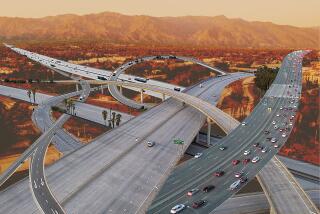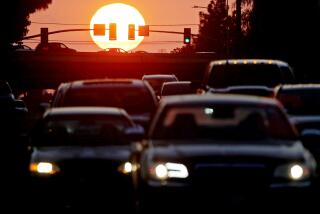TRANSPORTATION : New Patterns of Commuting Cause Traffic Jams in Suburbia
In Southern California, people commute from affordable housing in Riverside County to jobs in Orange County. Outside Washington, D.C., increasing numbers of people drive to and from work without ever entering the city. In metropolitan Chicago, officials are reporting record growth in suburban traffic.
From coast to coast, traffic patterns are changing dramatically as more and more people choose to both live and work in suburbs.
And the nation’s highways and mass transit systems, designed for an entirely different type of traffic pattern, find themselves increasingly unable to handle the ever-worsening suburban traffic sprawl.
THE PROBLEM: A study of 39 metropolitan areas across the country by the Texas Transportation Institute determined that automobile traffic increased on average by 14% from 1982 to 1988. And much of that increase involved new patterns of commuting.
Alan Pisarski, a Washington-based transportation policy consultant, said that the nation’s suburbs are now home to 60% of all workers in their respective metropolitan areas and account for 67% of metro job growth.
In fact, suburb-to-suburb car trips have become the dominant mode of commuting in America, Pisarski said. Trips that begin and end within a central city rank second, and traditional commuting from the suburbs to the city and back again is the least common today.
The old suburb-to-city commuting pattern lent itself easily to mass transit because it involved large numbers of people converging at a central destination. Commuting from one suburb to another, however, presents new problems, all leading to congestion on suburban roads.
The increasing dispersal of houses and jobs in suburban areas has resulted in people using more varied routes, making mass transit rarely feasible. Commuters must rely on their cars.
Moreover, the combined effect of the baby-boom generation hitting the labor market along with an influx of new female workers has added more cars to the traffic pattern than was ever imagined when the federal highway system was planned 35 years ago. The labor force grew 43% between 1960 and 1988, while the population as a whole only grew 27%.
Women often find it difficult to use mass transit because they often run errands for their families, making more than one stop in the course of a car trip or commute to work.
Anton Nelessen, a professor of urban planning and design at Rutgers University in New Jersey, said that decades of restrictive zoning practices have contributed to ever-expanding suburban sprawl.
“The job is never next to your house,” Nelessen said. “The office park is in one place, houses in one place and shopping centers in another place. Nothing is in walking distance.”
THE OUTLOOK: Congress is trying to get a grasp on the burgeoning problem. The Senate passed a five-year, $123-million transportation bill in June that would provide more money for mass transit, new highways, existing highway improvement and to help states adopt advanced traffic management technology.
Transportation legislation is also pending in the House, and Congress will take up the issue again when it returns from its summer recess in September.
Potential innovations under consideration include technologies for quickly informing motorists in their cars of traffic delays and alternative routes and automated freeways that would allow cars to travel closer to each other at higher speeds to increase highway capacity.
Local governments, meanwhile, are attempting to cope with the problem by encouraging increased use of existing mass transit and car-pooling.
However, Pisarski predicts that traffic won’t continue to increase at the same rate as it has since 1960. He said the baby-boom generation is maturing, and there are fewer young workers entering the labor force.
“We’re pretty much saturated in automobiles and auto drivers,” he said.
More to Read
Sign up for Essential California
The most important California stories and recommendations in your inbox every morning.
You may occasionally receive promotional content from the Los Angeles Times.









